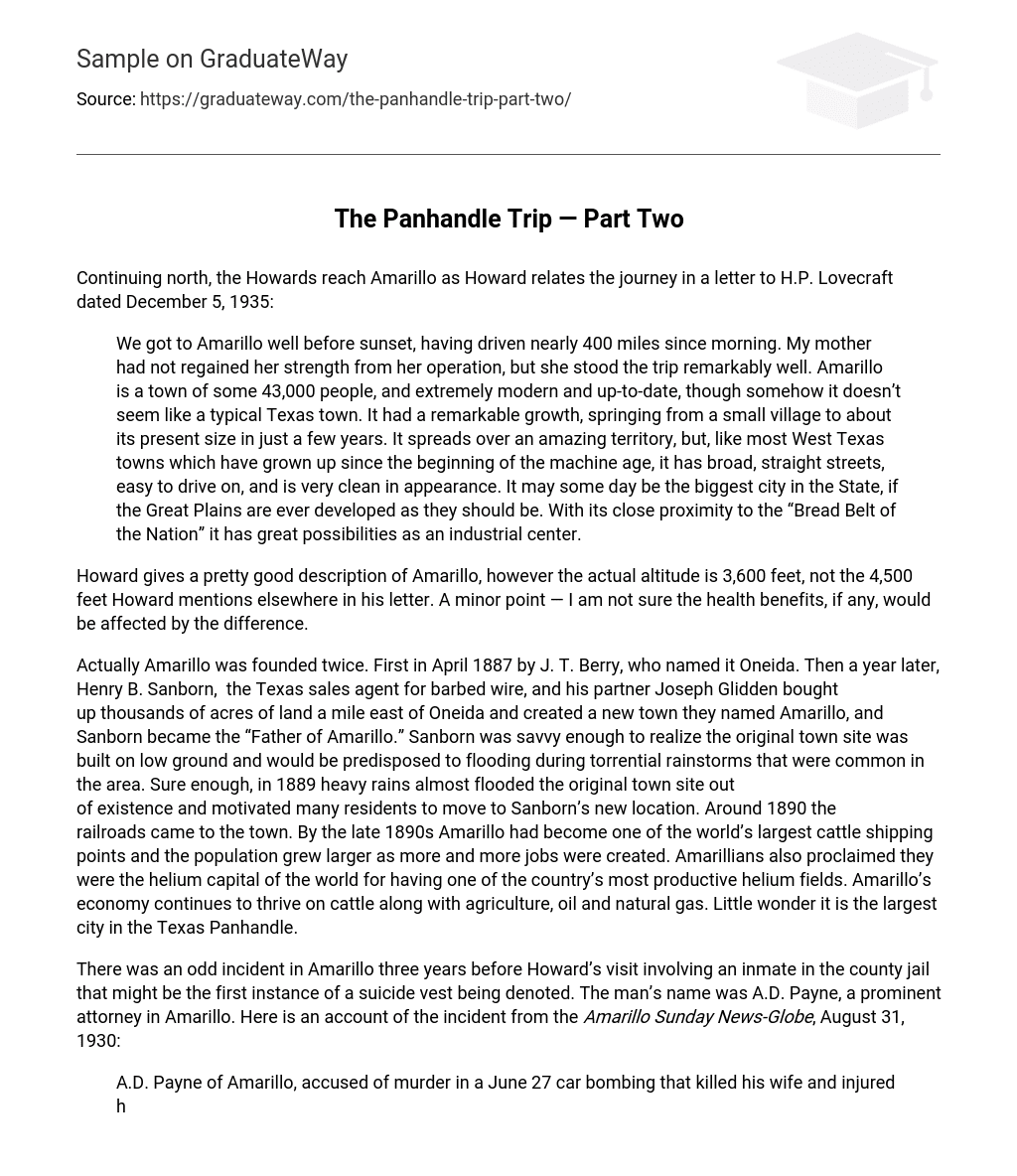Continuing north, the Howards reach Amarillo as Howard relates the journey in a letter to H.P. Lovecraft dated December 5, 1935:
We got to Amarillo well before sunset, having driven nearly 400 miles since morning. My mother had not regained her strength from her operation, but she stood the trip remarkably well. Amarillo is a town of some 43,000 people, and extremely modern and up-to-date, though somehow it doesn’t seem like a typical Texas town. It had a remarkable growth, springing from a small village to about its present size in just a few years. It spreads over an amazing territory, but, like most West Texas towns which have grown up since the beginning of the machine age, it has broad, straight streets, easy to drive on, and is very clean in appearance. It may some day be the biggest city in the State, if the Great Plains are ever developed as they should be. With its close proximity to the “Bread Belt of the Nation” it has great possibilities as an industrial center.
Howard gives a pretty good description of Amarillo, however the actual altitude is 3,600 feet, not the 4,500 feet Howard mentions elsewhere in his letter. A minor point — I am not sure the health benefits, if any, would be affected by the difference.
Actually Amarillo was founded twice. First in April 1887 by J. T. Berry, who named it Oneida. Then a year later, Henry B. Sanborn, the Texas sales agent for barbed wire, and his partner Joseph Glidden bought up thousands of acres of land a mile east of Oneida and created a new town they named Amarillo, and Sanborn became the “Father of Amarillo.” Sanborn was savvy enough to realize the original town site was built on low ground and would be predisposed to flooding during torrential rainstorms that were common in the area. Sure enough, in 1889 heavy rains almost flooded the original town site out of existence and motivated many residents to move to Sanborn’s new location. Around 1890 the railroads came to the town. By the late 1890s Amarillo had become one of the world’s largest cattle shipping points and the population grew larger as more and more jobs were created. Amarillians also proclaimed they were the helium capital of the world for having one of the country’s most productive helium fields. Amarillo’s economy continues to thrive on cattle along with agriculture, oil and natural gas. Little wonder it is the largest city in the Texas Panhandle.
There was an odd incident in Amarillo three years before Howard’s visit involving an inmate in the county jail that might be the first instance of a suicide vest being denoted. The man’s name was A.D. Payne, a prominent attorney in Amarillo. Here is an account of the incident from the Amarillo Sunday News-Globe, August 31, 1930:
A.D. Payne of Amarillo, accused of murder in a June 27 car bombing that killed his wife and injured his 11-year-old son, blasted his chest out with “some kind of infernal machine” while housed in the Hutchinson County jail. Payne had most of his cell mates move to another cell before he committed suicide with a self-inflicted blast. Payne was believed to have smuggled nitroglycerin into the jail.
Payne had plead insanity in the killing of his wife, partly because of financial problems and an extramarital affair. But he never got his day in court, instead choosing to go out with a bang.
During the time the Howards took their trip, Amarillo was a favorite tourist destination with its easy access by being the location were highways of 60, 66, 87 and 287 merged. This hub of highways made Amarillo a major tourist stop. The city had a number of hotels, tourist camps, motels, restaurants and souviner shops. But as the depths of the Great Depression set in, the city — like the rest of the country — suffered economically.
Early the following morning, the Howards rose early and took a drive out to the Canadian River to have a look what Howard described as “…a treacherous, turbulent river, running through shallow, rugged canyons. In some places dry canyons parallel the main bed, cut out by overflows, or caused by the river changing its course.” They then drove the 25 miles back to Amarillo for breakfast before driving southward back toward Cross Plains.
I doubt if just spending one night in the higher altitude of Amarillo would provide any therapeutic relief for Hester — a longer stay might have — but the trip did allow the family some stress free time together. It was a brief respite from the dark days ahead for the Howards.
Read Part One, Part Three, Part Four, Part Five





